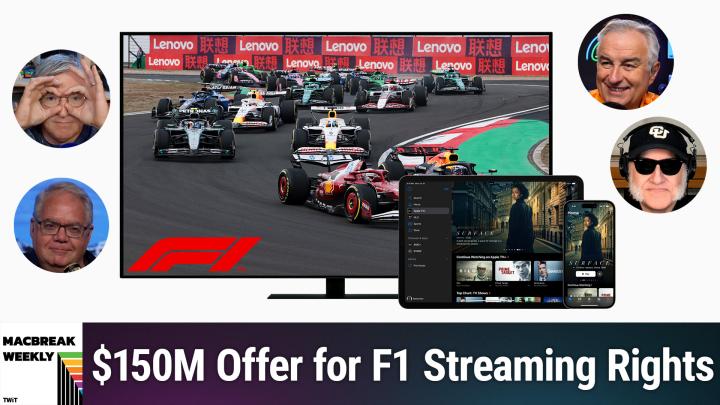Apple Eyes Formula 1 Rights with $150 Million Bid
AI-created, human-reviewed.
On a recent episode of MacBreak Weekly, hosts Leo Laporte, Andy Ihnatko, Alex Lindsay, and Jason Snell dissected Apple's aggressive pursuit of Formula 1 broadcasting rights in the United States, following reports that emerged from the prestigious Sun Valley Conference. The discussion revealed the complex dynamics at play when deep-pocketed tech companies compete with traditional broadcasters for premium sports content.
According to reporting from Dylan Byers at Puck, Apple CEO Tim Cook and senior vice president Eddy Cue met with Liberty Media CEO Greg Maffei to discuss Formula 1's American broadcasting future. The Cupertino company reportedly offered between $150-200 million for the rights, nearly doubling ESPN's current $85 million annual deal. This aggressive bidding strategy reflects Apple's continued investment in premium sports content for its Apple TV+ streaming platform.
The MLS Parallel and Its Cautionary Tale
The MacBreak Weekly panel drew immediate comparisons to Apple's Major League Soccer deal, where the company paid $250 million annually for exclusive streaming rights. As Jason Snell noted during the discussion, "It's the MLS cautionary tale. Apple gave Major League Soccer $250 million a year and then more money for Messi, et cetera, et cetera. But MLS has kind of disappeared, except for if you're on Apple TV, where it's all over the place."
This comparison highlights the central tension in Apple's sports strategy: substantial financial investment versus mainstream visibility. While Apple can offer Liberty Media significantly more money than traditional broadcasters, the trade-off involves potentially limiting Formula 1's exposure to casual American viewers who might discover the sport through ESPN's broader ecosystem.
Alex Lindsay provided additional context during the show, explaining that "F1 has a lot more exposure" than MLS had before Apple's involvement. He suggested that Apple's technological capabilities could enhance the viewing experience beyond traditional cable offerings, potentially adding dimensions to F1 coverage that conventional broadcasters cannot match.
Technology Meets Motorsport
The discussion revealed Apple's unique positioning in the sports broadcasting landscape. Unlike traditional networks focused primarily on audience metrics, Apple views sports content through a different lens. As Andy Ihnatko observed, "They don't necessarily you don't have to deliver an audience year after year after year." This approach allows Apple to make strategic investments in prestige content that may not immediately generate massive viewership but serves broader ecosystem goals.
The panelists noted Apple's existing relationship with Formula 1 through their upcoming racing film, which has already showcased innovative technology integration. Leo Laporte mentioned that "the experimental trailer that Apple released on the iPhone had haptics," demonstrating the company's commitment to enhancing the viewing experience through device integration.
Alex Lindsay emphasized the importance of Apple's executive enthusiasm for the sport, particularly noting that "there is an executive at EQ who is super excited about the product he's on Ferrari's board." This personal investment from Apple leadership could translate into more comprehensive coverage and promotional opportunities across Apple's product ecosystem.
Strategic Implications for Formula 1's American Growth
The bidding war reflects Formula 1's broader strategy to expand its American audience, following years of growth partly attributed to Netflix's "Drive to Survive" documentary series. However, as Jason Snell pointed out, "The complication here, which is super weird, is you can already buy a subscription to watch Formula One over the top," referring to F1's existing streaming service F1 TV.
This existing streaming option raises questions about Apple's strategic motivations. Snell suggested that the deal might serve as "a way to try out the Apple relationship before the international rights come up in 2030 and see if Apple would be a great long-term partner for F1 as a sport."
The geographic and timing challenges facing Formula 1 in America also factor into the equation. Alex Lindsay noted that "the US market is still a relatively small market for F1" and that "the time of the race is, in many cases, is the middle of the night," making it less suitable for live American viewing compared to other sports.
The Broader Streaming Wars Context
Apple's Formula 1 pursuit occurs within the larger context of streaming services competing for premium sports content. Traditional broadcasters like ESPN face increasing pressure from well-funded tech companies willing to pay premium prices for exclusive rights. The MacBreak Weekly discussion highlighted how Apple's approach differs fundamentally from traditional broadcasters, with the company viewing sports as part of a comprehensive ecosystem strategy rather than standalone profit centers.
The outcome of this bidding war will likely influence future negotiations between sports properties and streaming platforms, potentially setting precedents for how leagues balance immediate financial gains against long-term audience development. As Formula 1 continues its American expansion efforts, the choice between Apple's financial offer and ESPN's broader reach will test the sport's commitment to mainstream accessibility versus premium positioning.
Whether Liberty Media ultimately chooses Apple's substantial financial offer or ESPN's established broadcasting infrastructure will signal important trends in sports media's evolving landscape, where technology companies increasingly challenge traditional broadcasters for premium content rights.
Subscribe and never miss an episode! TWiT.tv/subscribe
Want ad-free Club TWiT exclusive podcasts? You can join Club TWiT for $10/month and get everything the club offers!
